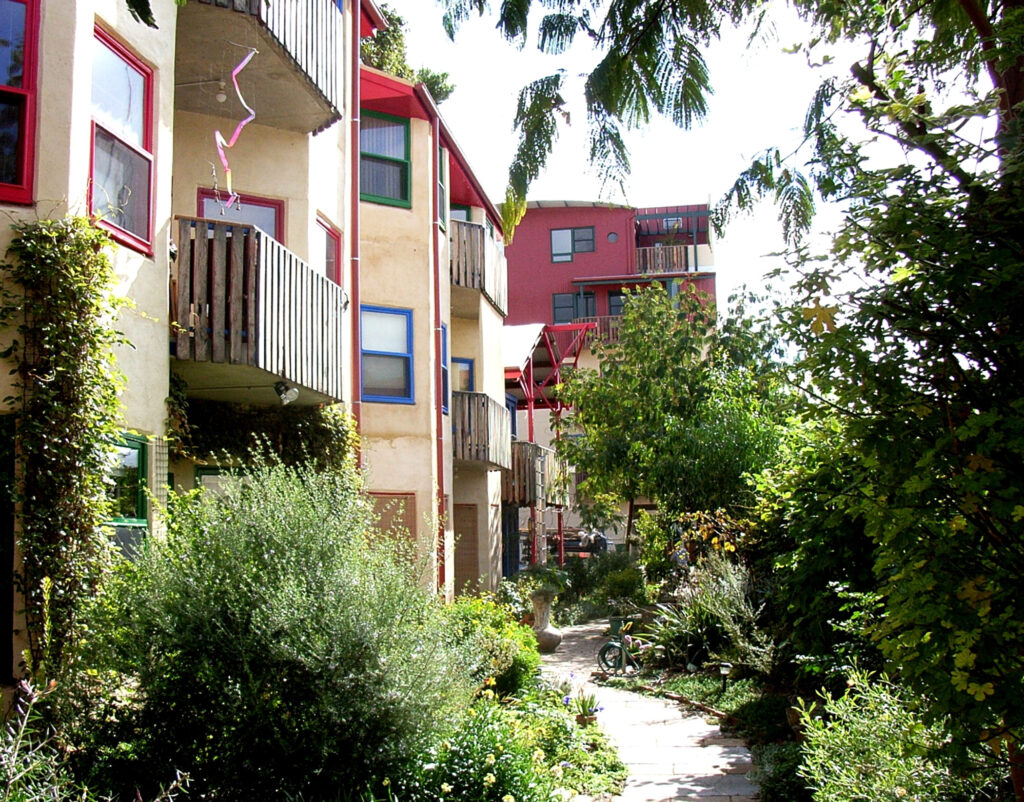Introduction
In the heart of the city of Adelaide there is a small community of 27 homes and gardens on 2,000 sq m (half an acre). It was named Christie Walk to honour the memory of Scott Christie, an environmental activist. The development combines many ecologically sustainable and community enhancing features.
It was initiated by UEA in 1999 as a demonstration project, to promote nature-friendly and people-friendly urban development by example. Construction was completed in December 2006.
The goal was to create a liveable, affordable and environmentally benign urban community that provides a practical prototype for the ecological development of our cities.
Project layout
The project consists of 27 dwellings which include:
- Four linked three-storey townhouses with full solar orientation.
- A three storey block of six apartments with east-west orientation
- Four individual cottages
- A 5 storey apartment block facing onto Sturt Street, with a community room/ kitchen/dining/meeting room/ library, and toilets on the ground floor.
Around 40 people live at Christie Walk, ranging in age from very young to over 80 with a strong ethos of ’community’ which has developed over the past ten years.

This big picture of global thinking is realised in many details ranging from the capture of stormwater to the use of solar electricity and recycled and non-toxic building materials.
The community aspect is important in a couple of ways. On the one hand, in the finished development the architecture and urban design fosters social interaction and a sense of community by providing a layout that is both free from traffic and provides a number of convivial outdoor places to gather informally or to sit quietly alone.
On the other hand, the fact that Christie Walk exists at all is due to the power of community activism and the commitment of individual Australians prepared to work together to achieve something out of the ordinary.
Environmental Performance Criteria
The building of Christie Walk was based on five key environmental performance criteria.
Both in construction and in its on-going life, to be a low energy demand environment and, within that, to maximise the use of renewable/solar-based energy sources and minimise the use of non-renewable energy sources.
Both in construction and in its on-going life, to maximise on-site both the retention and usage of storm water, and the retention and recycling of waste water.
To service the bringing of land, both in the location of the development and in associated rural location/s, into a state of ecological health, by adopting programs of ecological restoration and land management practices which may include appropriate organic agricultural production and which maximise achievement of biodiversity of indigenous flora and fauna.
Both in construction and in its on-going life, to avoid the use of products or processes which incorporate materials or produce substances or by-products which are known to be damaging to human health.
Both in construction and in its on-going life, to minimise or prevent the dispersion into the environment, either within or beyond the location of the development, of non-recyclable materials or materials which otherwise have detrimental environmental effects.
Case studies
Detailed descriptions of how these criteria are applied in practice are contained in various articles.
Find out more about Christie Walk
Here are the best ways to find out more:
- Explore the videos and storyboards on this site.
- Book an on-site tour.
- Follow our blog updates on our ongoing efforts at emissions reduction.

